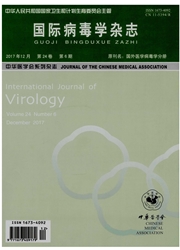

 中文摘要:
中文摘要:
目的分析山西省2011-2016年度流感病毒人间活动的分布情况及变化趋势,为今后流感防控工作提供科学依据。方法对2011-2016年度山西省流感病原学监测结果进行统计分析。结果2011年4月-2016年3月期间,山西省流感监测网络共检测流感样病例标本41724份,检出流感病毒核酸阳性标本7370份,总阳性率为17.66%,各年度阳性率呈现高、低值逐年交替出现的变化特征。2012—2013年度及2015—2016年度检出率最高,分别为21.99%、19.99%。每年10月一次年3月间均有一个流感病毒检出的显著高峰,另外,2012年夏季与2015年春季各有一个次高峰。5—14岁组人群流感病毒检出率最高,为22.98%。中部地区组流感病毒平均检出率(20.61%)高于南部地区组(14.76%)和北部地区组(13.22%)。结论山西省季节性流感在流行强度高的监测年度可出现一年两个流行高峰,开展全年流感监测具有现实意义。
 英文摘要:
英文摘要:
Objective To analyze the circulating distribution of influenza virus in humans and its yearly changes in Shanxi province during 2011-2016, so as to providescientific evidence for the prevention and control of influenza. Methods The data of pathogenic surveillance for influenza in Shanxi Province from April 2011 to March 2016 were analyzed. Results A total of 41 724 ILI samples were collected. Nucleic acid of influenza virus was detected in 7 370 samples by Shanxi Influenza Surveillance net from April 2011 to March 2016. The total positive rate of influenza virus in ILI throat swab was 17.66% and the data were characterized by annual fluctuation between higher value and lower value. The positive rates of influenza virus in 2012-2013 (21.99%) and 2015-2016 (19.99%) were the highest. There're a big peak between each October and next March and a second highest peak in both summer in 2012 and spring in 2015. The positive rate of influenza virus' in the age group of 5 to 14 (22.98%) was the highest. The mean detection rate of influenza virus in the central region (20.61%) of Shanxi is higher than that of northern area (13.22%) and southern area (14.76%). Conclusions Seasonal influenza epidemics in Shanxi area will show two peaks in the years with higher prevalence. Therefore, It's realistic to monitor influenza virus all of year in Shanxi.
 同期刊论文项目
同期刊论文项目
 同项目期刊论文
同项目期刊论文
 期刊信息
期刊信息
